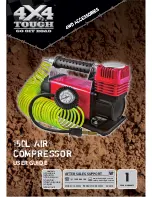
8
GLOSSARY
Become familiar with these terms before operating the unit.
CFM
: Cubic feet per minute.
SCFM:
Standard cubic feet per minute; a unit of measure of air delivery.
PSIG:
Pounds per square inch gauge; a unit of measure of pressure.
Code Certification:
Products that bear one or more of the following marks: UL, CUL,
ETL, CETL,
CSA/US
have been evaluated by OSHA certified independent safety
laboratories and meet the applicable Underwriters Laboratories Standards for Safety.
CSA:
Electrical products sold in Canada are required to be certified to the applicable
CSA standard (s). Canadian Standards Association (CSA) is a standards writing and
safety testing organization. Products that are CSA certified have been evaluated and
tested and found to meet or exceed the applicable CSA standard (s) for safety and
electrical performance.
Cut-In Pressure:
While the motor is off, air tank pressure drops as you continue to
use your accessory. When the tank pressure drops to a certain low level the motor will
restart automatically. The low pressure at which the motor automatically restarts is
called “cut-in” pressure.
Cut-Out Pressure:
When an air compressor is turned on and begins to run, air
pressure in the air tank begins to build. It builds to a certain high pressure before the
motor automatically shuts off - protecting your air tank from pressure higher than its
capacity. The high pressure at which the motor shuts off is called “cut-out” pressure.
Branch Circuit:
Circuit carrying electricity from electrical panel to outlet.
Model No.
FSCP200
Voltage/Hertz/ Phase
120V/60/1
Minimum Branch Circuit Requirement
15 amps
*Fuse Type
Time Delay
Air Tank Capacity
2 Gallons
Approximate Cut-in Pressure
90 PSI
Approximate Cut-out Pressure
125 PSI
SPECIFICATIONS
* A circuit breaker is preferred. Use only a fuse or circuit breaker that is the same rating
as the branch circuit on which the air compressor is operated. If compressor is connected
to a circuit protected by fuses, use only time delay fuses. Time delay fuses should be
marked “D” in Canada and “T” in the US.
INSTALLATION
Location of the Air Compressor
Locate the air compressor in a clean, dry and well ventilated area. The air compressor
should be located at least 12" away from the wall or other obstructions that will
interfere with the flow of air. The air compressor pump and shroud are designed to
allow for proper cooling. The ventilation openings on the compressor are necessary to
maintain proper operating temperature. Do not place rags or other containers on or
near these openings.
HOW TO SET UP YOUR UNIT
641915-00,FSCP200 Compressor 3/14/06 7:31 AM Page 8









































